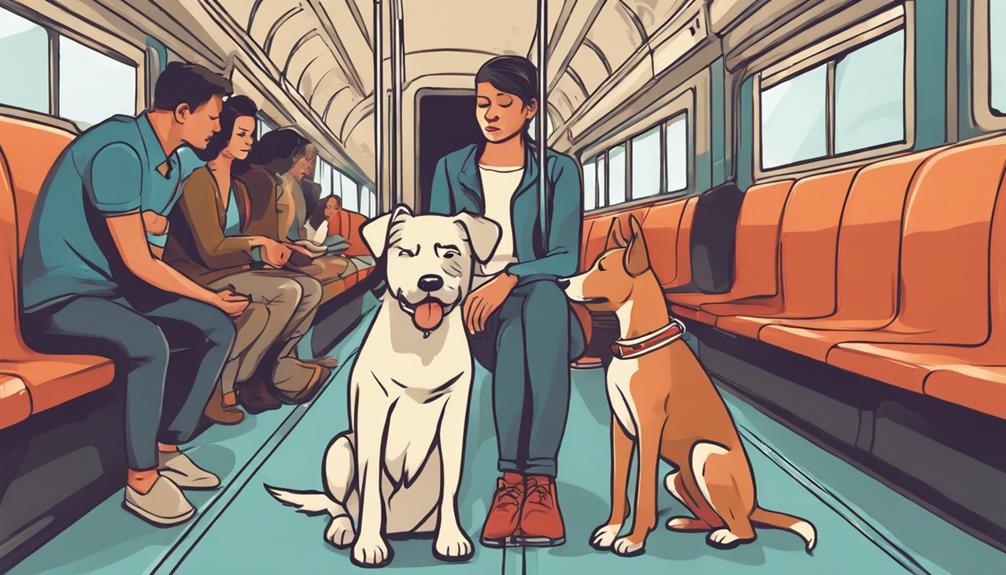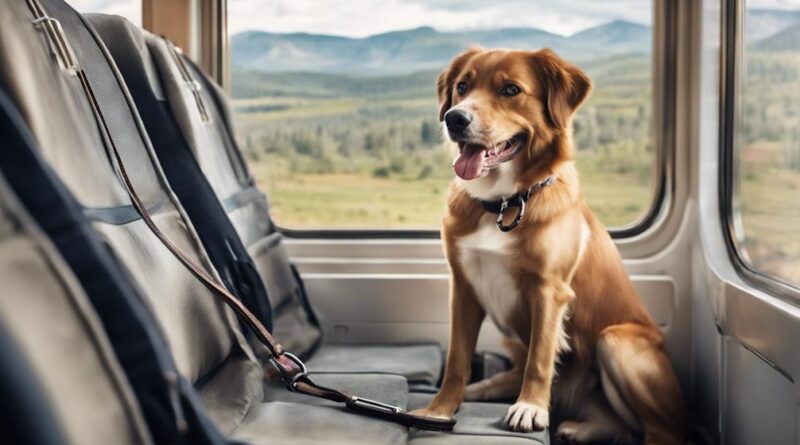7 Key Tips for Train Travel With Your Dog
You might think train travel with your dog is too much of a hassle, but with the right preparation, it can be a smooth experience for both of you.
Ensuring your furry companion's safety and comfort during the journey is crucial. From choosing the correct carrier to managing their behavior onboard, these 7 key tips will help you navigate train travel with your dog effortlessly.
So, are you ready to make your next train trip with your canine companion stress-free and enjoyable?
Choosing the Right Size Carrier
When selecting a carrier for your dog, ensure it comfortably accommodates their size and allows them to move freely. Carrier safety is paramount, so check for weight restrictions to ensure your furry friend is secure during travel. A carrier that's too small can cause discomfort, while one that's too large may lead to your dog sliding around during the journey.
Consider carriers with comfort features such as padded interiors or removable bedding to keep your dog cozy. Ventilation options are crucial to ensure your pet has a fresh airflow while inside the carrier. Look for carriers with mesh panels or windows that allow for proper air circulation.
Opt for carriers with sturdy construction and secure closures to prevent any mishaps during transit. It's essential that the carrier can withstand the bumps and movements that come with train travel. Double-check that all zippers, latches, and seams are in good condition before departing.
Preparing Your Dog for Travel
Ensure your dog is comfortable and ready for travel by following these essential preparation steps.
First and foremost, consider training tips to help your furry friend feel at ease during the journey. Practice short trips in the car or on public transportation to acclimate your dog to the motion and sounds of travel. Reward calm behavior with treats or praise to reinforce positive associations with traveling.
If your dog experiences travel anxiety, consult with a veterinarian or professional trainer for guidance. They may recommend techniques such as desensitization or counterconditioning to help your dog manage their stress. Additionally, consider using calming aids like pheromone sprays or natural supplements to promote relaxation.
Before the trip, ensure your dog is up to date on vaccinations and pack any necessary medications. Familiarize yourself with the train's pet policy and ensure your dog meets all requirements for travel. On the day of departure, provide your dog with a balanced meal a few hours before boarding to prevent motion sickness.
Packing Essential Items for Your Dog
Consider packing essential items such as your dog's food, water, leash, and favorite toys to ensure comfort and familiarity during train travel. When preparing for the journey with your furry friend, remember to cater to their needs to make the trip enjoyable for both of you.
- Proper hydration: Keep your dog hydrated throughout the journey by bringing an ample supply of water and a portable water bowl.
- Snacks for distractions: Pack some of your dog's favorite treats to provide them with comfort and distractions during the trip.
- Calming aids: If your dog tends to get anxious during travel, consider bringing calming aids like a familiar blanket or a pheromone collar to help them relax.
- Toys for entertainment: Bring along toys that your dog loves to keep them entertained and engaged during the train ride.
Ensuring Your Dog's Comfort on the Train
Pack your dog's bed or a comfortable blanket to create a cozy spot for them to relax and rest during the train journey. This familiar item will provide a sense of security and comfort for your furry friend in an unfamiliar environment. To further enhance your dog's comfort, consider using calming techniques such as playing soothing music or using calming pheromone sprays designed for pets.
When selecting your seating arrangements on the train, opt for a space that allows your dog to sit or lie down comfortably. Choose a seat where your dog can stay close to you, whether it's on the floor next to your feet or on a seat beside you. This proximity will help your dog feel more at ease during the journey. Additionally, bring along your dog's favorite toys or chew treats to keep them occupied and engaged while on the train.
Remember to keep an eye on your dog's body language throughout the journey. If you notice signs of stress or discomfort, try using gentle massage or reassuring words to help calm them down. By prioritizing your dog's comfort and well-being, you can ensure a more enjoyable and stress-free train travel experience for both you and your furry companion.
Familiarizing Your Dog With the Train
Introduce your dog to the sights and sounds of the train station before boarding to help them acclimate to the environment. This step is crucial in ensuring a smooth and stress-free train travel experience for your furry friend.
To familiarize your dog with the train, consider the following tips:
- Positive reinforcement training: Use treats and praise to associate the train station and trains with positive experiences for your dog.
- Desensitization: Gradually expose your dog to train-related sounds such as whistles, announcements, and the rumble of the train to help them get used to these noises.
- Creating a calm environment: Keep your dog calm by maintaining a relaxed demeanor yourself. Dogs often mirror their owner's emotions, so staying composed can help them feel more at ease.
- Gradual exposure: Start by spending short periods at the train station with your dog, gradually increasing the duration of your visits. This will help your dog adjust to the hustle and bustle of the station.
Following Train Pet Policies
Before embarking on your train journey with your furry companion, ensure that you adhere to the train pet policies to make the trip hassle-free for both you and your dog. Reviewing documentation is crucial before your trip. Make sure you have all the necessary paperwork such as vaccination records, health certificates, and any required identification tags for your dog. These documents may be needed to comply with the train company's policies and regulations.
Understanding restrictions is also key. Different train companies have varying rules regarding pet travel. Some may have specific size or weight limitations for pets, while others may restrict certain breeds. It's essential to check and comply with these restrictions to avoid any issues during your journey. Additionally, familiarize yourself with any designated pet areas on the train and follow the guidelines provided by the train staff.
Managing Your Dog's Behavior on the Train

To ensure a smooth train journey with your dog, focus on maintaining your furry companion's behavior throughout the trip. Utilizing positive reinforcement and effective training techniques can help your dog stay calm and well-behaved during the train ride.
- Use positive reinforcement: Reward good behavior with treats or praise to encourage your dog to continue behaving well. This will reinforce positive behaviors and make the train journey more enjoyable for both you and your pet.
- Practice basic training techniques: Before the trip, make sure your dog is familiar with basic commands such as 'sit,' 'stay,' and 'quiet.' This will help you control your dog's behavior in the confined space of the train.
- Keep your dog occupied: Bring along your dog's favorite toys or chews to keep them entertained during the journey. A busy dog is less likely to exhibit disruptive behavior.
- Stay calm and patient: Dogs can sense your emotions, so try to remain calm and patient throughout the trip. If your dog does misbehave, address the behavior calmly and consistently without resorting to punishment.
Handling Potty Breaks and Cleanups
Ensure you have appropriate supplies for handling your dog's potty breaks and cleanups during the train journey. Potty training is essential for a smooth trip. Start by scheduling breaks at regular intervals, considering your dog's age and bladder capacity. Before departing, make sure you have waste disposal bags, cleaning wipes, and paper towels readily available.
When your dog signals it's time for a potty break, act promptly. Most trains have designated areas for pet waste disposal, so take advantage of these spots. Always clean up after your dog to be courteous to other passengers and maintain cleanliness. If your dog has an accident, remain calm and address it immediately. Use cleaning wipes to sanitize the area and eliminate any odors.
During the journey, keep an eye on your dog's behavior to anticipate when they may need a break. Avoid feeding your dog large meals right before the trip to minimize accidents. Remember that accidents can happen, especially if your dog isn't used to traveling by train. Be patient and understanding throughout the journey, and handle potty breaks and cleanups efficiently to ensure a pleasant experience for both you and your furry companion.
Frequently Asked Questions
Can My Dog Travel on the Train Without a Carrier?
Yes, your dog usually needs to be in a carrier on the train for safety and comfort reasons. Off-leash etiquette and noise management are crucial when traveling with your dog.
Keep your furry friend secure in a carrier to ensure a smooth train ride for everyone. Remember to consider the well-being of your fellow passengers and follow the train's guidelines for pet travel.
Are There Any Restrictions on the Size or Breed of Dogs Allowed on Trains?
When traveling with your dog on a train, remember that there might be breed restrictions and size limitations in place. Some train companies may not allow certain breeds or large dogs onboard for safety reasons.
Make sure to check with the train company beforehand to see if there are any restrictions that apply to your dog. It's always better to be prepared and avoid any last-minute surprises.
Can My Dog Accompany Me in the Dining Car or Other Public Areas of the Train?
Yes, you can bring your dog with you in the dining car or other public areas of the train. It's a great way to practice pet-friendly etiquette and provide socialization opportunities for your furry friend. Just make sure to follow any specific rules or guidelines regarding pets in these areas to ensure a pleasant experience for both your dog and your fellow passengers.
Enjoy your journey with your canine companion!
What Should I Do if My Dog Becomes Anxious or Scared During the Train Ride?
If your dog becomes anxious or scared during the train ride, try comforting techniques like petting or speaking softly to them.
You can also use calming aids such as pheromone sprays or natural remedies.
Distraction methods like playing with their favorite toy or engaging in bonding exercises like practicing obedience commands can also help ease their stress.
Are There Any Specific Rules or Regulations Regarding Feeding My Dog on the Train?
When traveling with your dog on the train, it's important to be mindful of the feeding schedule and potty breaks.
Some trains may have specific rules about feeding your pet onboard, so it's best to check with the train company beforehand. Make sure to plan your dog's meals around the train schedule to avoid any accidents.
Additionally, take advantage of designated potty breaks during stops to ensure your furry companion stays comfortable throughout the journey.
Conclusion
Now that you have all the tips for train travel with your dog, you're ready to embark on your journey with your furry companion. Remember to choose the right carrier, pack essential items, and make sure your dog is comfortable throughout the trip.
Familiarize them with the train, follow pet policies, and manage their behavior. With these key tips in mind, you and your dog can enjoy a smooth and stress-free train ride together.
Safe travels!
